Overwintering Tropicals: Part I
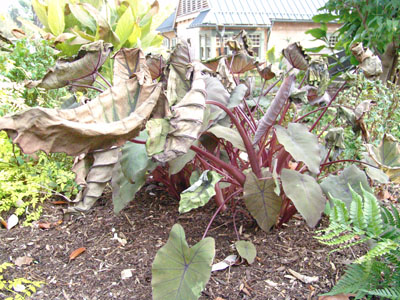 As fall approaches many gardeners start to make preparations for the end of the garden season. As much as we wish the season would go on forever we know that an inevitable killing frost looms around the corner.
As fall approaches many gardeners start to make preparations for the end of the garden season. As much as we wish the season would go on forever we know that an inevitable killing frost looms around the corner.

Cosby Courtyard showcased tropical containers this September. photo credit: D. Mattis
In recent years tender perennials and tropicals have been popularized by public gardens such as Chanticleer, the Scott Arboretum, and the Morris Arboretum. It is not uncommon now to see bananas, cannas, elephant ears, gingers, bromeliads, and other tropical plants used freely in home gardens.
While these plants provide a unique look there is always the question as fall approaches, “What should I do with these plants?” Many are quite pricey in the nurseries, so the option of letting them die from a killing frost as you would a petunia or marigold, is not a viable option for most – and it shouldn’t be.
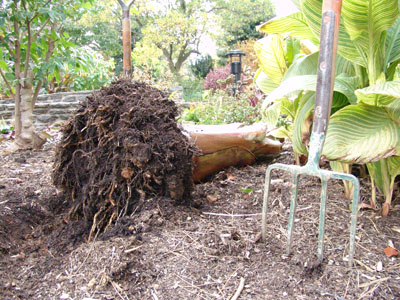
Ensete ventricosum 'Maurelii' being harvested from the garden for overwintering. photo credit: R. Robert
There are extremely simple and productive methods for saving many of the tropical plants in your garden. Not only will you have the plants for the next year, but each year the size of the plant will increase. Thus you will produce more and more plants for your garden or to be shared with your fellow gardeners. This month we will discuss some of the techniques you can use in your garden.
Before you even get started with the evaluation of what is reasonable to keep and what you might want to buy new next year, you need to determine if you have a proper place for storage. I live in Swarthmore which is notorious for basements that either take on water in storms or are simply moist and humid, limiting what you can store in them. If you have a basement, cellar, crawl space, etc. which you have always thought had its limitations, this is the perfect place and condition for overwintering your tropicals and tender perennials.
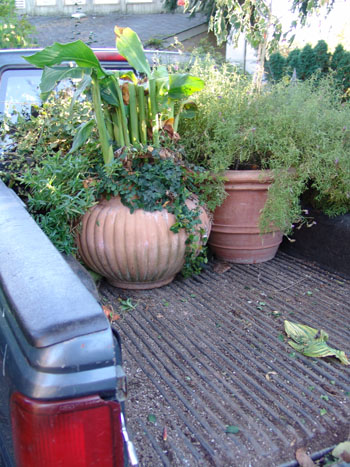
Loading the truck, as we prepare to harvest the plants for overwintering. photo credit: R. Maurer
You may have other places such as an outdoor shed or garage you might be considering. The critical parameter for storage of these plants is that the air temperature stays between 45 and 60 degrees. It is also beneficial, although not critical, that there be some humidity in the air. Often garages get too cold or stay too warm for effective overwintering. If the basement is dark, that’s even better. Essentially, you want a space where the plants can go into a semi-state of dormancy, but remain warm enough not to decay, rot, or die.
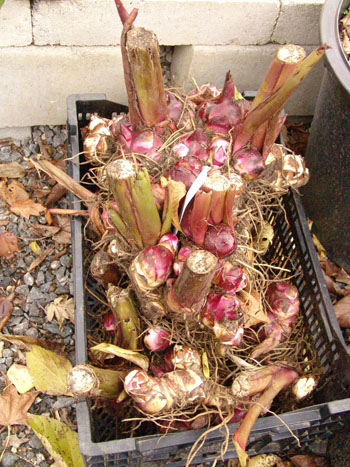
Harvested tubers of Canna musifolia. photo credit: R. Robert
Now you can look at your garden and start to categorize your tropical and tender plants. Probably the largest groups of plants are those you will be over-wintering as a bulb, rhizome, tuber, fleshy root, etc. This includes such plants as, Musa, banana; Musella, Chinese yellow banana; Ensete, Red Abyssinian banana; Canna; Hedychium, ginger; Alocasia, Colocasia, Xanthosoma, elephant ears; Alpinia; and many more.
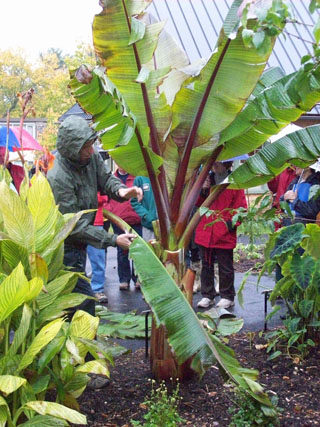
Andrew Bunting removing the foliage from Ensete ventricosum 'Maurelii' in preparation for overwintering the plant. photo credit: J. Coceano
Each of these can be treated slightly differently, but the same general treatment applies to all. For the bananas-Musa, Musella and Ensete wait for the first light frost. At this point take your Felco pruners and cut all the foliage as tightly as you can back to the main stem of the banana. In some cases you will end up with a stalk over six feet tall with no leaves. Then with a digging fork start loosely digging around the base of the banana. You want to loosen the soil from the roots, but keep as many roots as possible. Bananas are very shallow rooted for such a large trunk.
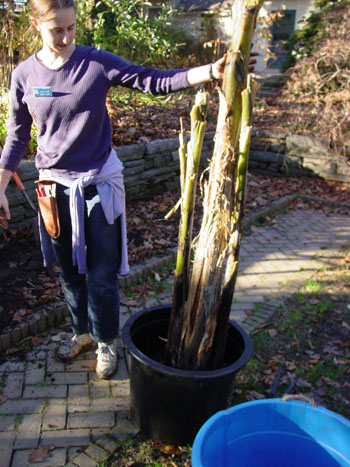
Placing banana in large plastic pot. photo credit: R. Robert
Once the banana has been extricated find a large plastic nursery pot or crate. Replant the banana in the pot. I like to use a material that is free draining, but will stay slightly moist. Generally I use triple-shredded bark mulch. This can be bought in bags or in bulk. I would recommend bags unless you have a large number of tropicals to overwinter. The use of this material applies to all the other aforementioned tropicals.
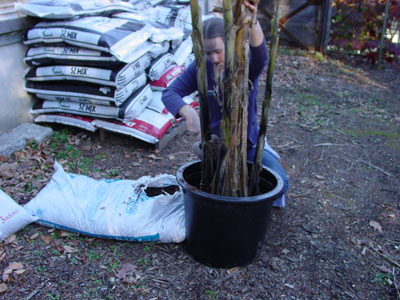
Filling the pot with triple-shredded bark mulch. photo credit: R. Robert
If it is a large nursery pot I fill the pot one-third of the way full. I set in the banana and fill the mulch to the base of the plant where the roots meet the stem. The mulch usually comes out of the bag slightly moistened, which is good. You should not have to pre-moisten your mulch. Watering the mulch should be avoided because this can contribute to rotting during the winter.
Materials other than mulch which can be used include leaf compost or compost. I would avoid soil because it is not porous enough to allow good air exchange and is too heavy a substance and will contribute to rotting of the plant. I would also avoid peat moss. Many institutions are trying to avoid peat moss altogether because of the environmental implications of harvesting peat. Also, as a potting mix for tropical plants it tends to stay too wet or too dry.
Once the bananas are potted they can be set in the basement. If you have access to wooden pallets you may want to put them on the floor and put the containers of tropicals on them. This will provide good air circulation underneath your plants. If the banana is taller than the ceiling of your basement, it can be leaned on its side; however, you will have to place something on top of the pot to hold in the loose mulch. With all your plants, label them before you put them to bed for the winter.
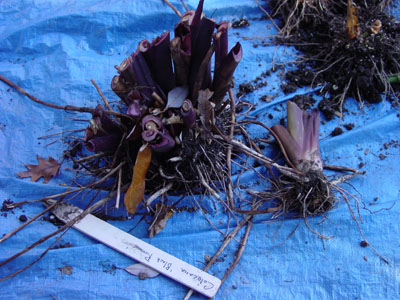
Colocasia 'Black Runner' tuber awaiting overwintering. photo credit: R. Robert
Check in next week to learn how to handle Canna, Alocasia, Colocasia, Xanthosoma, Hedychium, and Alpinia. Subscribe to the blog by clicking the subscribe button at the top of the screen.





Barbara Shaw
Posted at 08:49h, 09 NovemberGreat follow-up to the Arboretum Assistant talk.
Eunice Silver
Posted at 16:37h, 09 NovemberWould you store dahlia tubers in mulch/leaf compost?
Andrew Bunting
Posted at 10:57h, 10 NovemberWith regards to dahlias we cut the foliage and stems off leaving the tuber. They then can be placed in a crate or a black plastic pot with some mulch or compost underneath the tube and then some on top as well. Placing them in a cellar or the a basement with similar conditions would be best.
Andrew Bunting, Curator
Eunice Silver
Posted at 09:32h, 13 NovemberThanks!
Ted Patterson
Posted at 16:57h, 15 NovemberRe: dahlias, the Colorado Dahlia Society has several articles and links on storing tubers over the winter.
http://www.dahlias.net/seabox/savem.htm
http://www.dahlias.net/dahwebpg/CultureIndex/Culture.htm